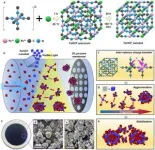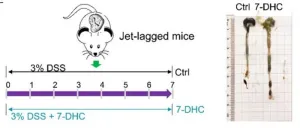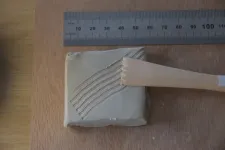(Press-News.org) Plastic waste breaks down over time into microplastics (<0.1 μm). Microplastics smaller than 20 μm cannot be removed in currently operating water treatment plants and must be agglomerated to a larger size and then removed. Iron (Fe) or aluminum (Al) based flocculants are used for this purpose, but they are not the ultimate solution as they remain in the water and cause severe toxicity to humans, requiring a separate treatment process.
Dr. Jae-Woo Choi of the Center for Water Cycle Research at the Korea Institute of Science and Technology (KIST) has developed an eco-friendly metal-organic skeleton-based solid flocculant that can effectively aggregate nanoplastics under visible light irradiation.
Prussian blue, a metal-organic frameworks-based substance made by adding iron (III) chloride to a potassium ferrocyanide solution, is the first synthetic pigment used to dye jeans a deep blue color and has recently been used to adsorb cesium, a radioactive element, from Japanese nuclear plant wastewater. While conducting experiments on the removal of radioactive materials from water using Prussian blue, the KIST research team discovered that Prussian blue effectively aggregates microplastics under visible light irradiation.
The research team developed a material that can effectively remove microplastics by adjusting the crystal structure to maximize the aggregation efficiency of Prussian blue. When the developed material is irradiated with visible light, microplastics with a diameter of about 0.15 μm (150 nm), which are difficult to remove using conventional filtration technology, can be agglomerated to a size about 4,100 times larger, making them easier to remove. In experiments, the researchers found that they were able to remove up to 99% of microplastics from water. The developed material is also capable of flocculating microplastics more than three times its own weight, outperforming the flocculation efficiency of conventional flocculants using iron or aluminum by about 250 times.
The material not only uses Prussian blue, which is harmless to the human body, but is also a solid flocculant, making it easy to recover residues in water. It also uses natural light as an energy source, enabling a low-energy process.
"This technology has a high potential for commercialization as a candidate material that can be applied to general rivers, wastewater treatment facilities, and water purification plants," said Dr. Choi of KIST. "The developed material can be utilized not only for nanoplastics in water, but also to clean up radioactive cesium, thus providing safe water." Meanwhile, Dr. Youngkyun Jung, the first author of the paper, said, "The principle of this material can be utilized to remove not only microplastics, but also a variety of contaminants in water systems."
###
KIST was established in 1966 as the first government-funded research institute in Korea. KIST now strives to solve national and social challenges and secure growth engines through leading and innovative research. For more information, please visit KIST’s website at https://eng.kist.re.kr/
The research, which was supported by the Ministry of Science and ICT (Minister Lee Jong-ho) through the Material Innovation Leading Project (2020M3H4A3106366) and the KIST Institutional Project (2E32442), was published on October 1 in the international journal Water Research.
END
Safely removing nanoplastics from water using 'Prussian blue', a pigment used to dye jeans
Microplastics can be removed by 99% with flocculants alone, without any additional equipment, by irradiating them with sunlight
2023-10-20
ELSE PRESS RELEASES FROM THIS DATE:
Body image, social media and gender biases associated with kids quitting sports
2023-10-20
ORLANDO, Fla. (October 20, 2023) – Body image issues, social media, gender biases and coaching styles may be causing young athletes to quit sports, according to research presented by Nemours Children’s Health at the 2023 American Academy of Pediatrics (AAP) National Conference & Exhibition.
Previous studies have found that 70% of children quit sports by age 13, and by age 14 girls quit at twice the rate of boys.
“Youth sports participation sets up children for a lifetime of healthy habits. Kids who participate ...
AAP 2023: Nemours Children’s presents research on body image & sports attrition, social determinants & obesity, and autism screening in primary care
2023-10-20
JACKSONVILLE, Fla. (October 20, 2023) – Researchers from Nemours Children’s Health will present findings from a range of studies, and Nemours physician Steven Selbst, MD, will receive the Jim Seidel Distinguished Service Award for emergency medicine contributions at the American Academy of Pediatrics (AAP) National Conference & Exhibition, Oct. 20 – 24 in Washington, DC.
“Nemours’ vision is to go well beyond medicine – to help children everywhere stay healthy and grow into healthy adults,” ...
American Academy of Pediatrics reviews toddler ‘formulas,’ questions marketing of drinks
2023-10-20
Media contacts: Lisa Black, lblack@aap.org; or Adam Alexander, aalexander@aap.org
Toddler “formulas” that are promoted as nutritious drinks for the older infant or preschooler are generally unnecessary and nutritionally incomplete, and the marketing practices that promote them are questionable, according to the American Academy of Pediatrics.
The AAP has published a new clinical report, “Older Infant-Young Child ‘Formulas,’ ” that reviews the growing array of drinks aimed at children ages 6-36 months and observes ...
Algorithm and blues: how to judge music plagiarism?
2023-10-20
Ed Sheeran convinced a jury this year that he didn’t rip off Marvin Gaye’s `Let’s Get It On.’ By way of contrast, Pharrell Williams and Robin Thicke earlier failed to establish that `Blurred Lines’ wasn’t a copy of Gaye’s `Got to Give It Up.’
Could automated algorithms bring a new objectivity to music copyright infringement decisions, limiting the number, scale and expense of court cases?
Musicologist Dr Patrick Savage of the University of Auckland researched the topic in collaboration with Yuchen Yuan of Keio University, ...
Gut microbiota-derived 7-DHC ameliorates circadian rhythm disorders and inflammatory bowel disease (IBD)
2023-10-20
Inflammatory bowel disease (IBD) is a chronic inflammatory disease of the gastrointestinal tract categorized into ulcerative colitis and Crohn's disease. Currently, aminosalicylates, glucocorticoids, immunomodulating drugs, and biological agents are common strategies for the treatment of IBD. The efficacy of these therapies is limited, however, and they are frequently associated with multiple adverse effects.
Recently, Life Metabolism published a study entitled “7-Dehydrocholesterol protects against circadian disruption and experimental colitis: potential role of RORα/γ”, which shows that gut microbiota-derived metabolite ...
Sustainable cosmetics: harnessing cyanobacteria for natural active ingredients
2023-10-20
The cosmetics industry is turning towards natural alternatives to chemical agents used in products to pave way towards a more sustainable future. Researchers are searching for nature-derived active ingredients for skincare products through extensive bioprospecting research. In this regard, cyanobacteria, with their remarkable metabolic capacity, are a promising source of such agents. Having existed on Earth for nearly 3.5 billion years, these photosynthetic organisms have adapted to various environmental ...
Consistent lack of sleep is related to future depressive symptoms
2023-10-20
Consistently sleeping less than five hours a night might raise the risk of developing depressive symptoms, according to a new genetic study led by UCL (University College London) researchers.
Historically, poor sleep has been seen as a side effect of mental ill health, but this study found that the link between sleep and mental illness is more complex.
The study, published in the journal Translational Psychiatry, analysed data from people with an average age of 65 and found short sleep was associated with the onset of depressive symptoms.
Lead author Odessa S. Hamilton (UCL Institute of Epidemiology ...
Identifying the maker of an artwork by fingerprint examination
2023-10-20
Dzemila Sero, now Migelien Gerritzen Fellow at the Rijksmuseum and former postdoc at the Centrum Wiskunde & Informatica, together with a team of researchers from the Rijksmuseum, Leiden and Cambridge University, examined the terracotta sculpture Study for a Hovering Putto attributed to Laurent Delvaux (1696 - 1778) and housed in the Rijksmuseum permanent collection.
The methodology and findings were published open access in Science Advances in a paper with title "Artist profiling using micro-CT scanning of a Rijksmuseum terracotta sculpture".
To acquire preserved impressions on the sculpture, researchers ...
Dietary supplement modifies gut microbiome – potential implications for bone marrow transplant patients
2023-10-20
Researchers at Baylor College of Medicine and the University of Michigan conducted a phase I pilot study to assess the feasibility of using potato starch as a dietary intervention to modify the gut microbiome in bone marrow transplant patients. The study, which appears in the journal Nature Medicine, is the first part of a two-phase ongoing clinical trial evaluating the effect of modifying the microbiome on the incidence of graft-versus-host disease (GVHD), a major complication that develops in up to half ...
Keeping a human in the loop: Managing the ethics of AI in medicine
2023-10-20
Artificial intelligence (AI)—of ChatGPT fame—is increasingly used in medicine to improve diagnosis and treatment of diseases, and to avoid unnecessary screening for patients. But AI medical devices could also harm patients and worsen health inequities if they are not designed, tested, and used with care, according to an international task force that included a University of Rochester Medical Center bioethicist.
Jonathan Herington, PhD, was a member of the AI Task Force of the Society for Nuclear Medicine and Medical Imaging, which laid out recommendations on how to ethically develop and use AI medical devices in two papers published ...
LAST 30 PRESS RELEASES:
First ‘Bible map’ published 500 years ago still influences how we think about borders
Why metabolism matters in Fanconi anemia
Caribbean rainfall driven by shifting long-term patterns in the Atlantic high-pressure system, study finds
Potential treatment to bypass resistance in deadly childhood cancer
RSV vaccines could offer protection against asthma
Group 13 elements: the lucky number for sustainable redox agents?
Africa’s forests have switched from absorbing to emitting carbon, new study finds
Scientists develop plastics that can break down, tackling pollution
What is that dog taking? CBD supplements could make dogs less aggressive over time, study finds
Reducing human effort in rating software
Robots that rethink: A SMU project on self-adaptive embodied AI
Collaborating for improved governance
The 'black box' of nursing talent’s ebb and flow
Leading global tax research from Singapore: The strategic partnership between SMU and the Tax Academy of Singapore
SMU and South Korea to create seminal AI deepfake detection tool
Strengthening international scientific collaboration: Diamond to host SESAME delegation from Jordan
Air pollution may reduce health benefits of exercise
Ancient DNA reveals a North African origin and late dispersal of domestic cats
Inhibiting a master regulator of aging regenerates joint cartilage in mice
Metronome-trained monkeys can tap to the beat of human music
Platform-independent experiment shows tweaking X’s feed can alter political attitudes
Satellite data reveal the seasonal dynamics and vulnerabilities of Earth’s glaciers
Social media research tool can lower political temperature. It could also lead to more user control over algorithms.
Bird flu viruses are resistant to fever, making them a major threat to humans
Study: New protocol for Treg expansion uses targeted immunotherapy to reduce transplant complications
Psychology: Instagram users overestimate social media addiction
Climate change: Major droughts linked to ancient Indus Valley Civilization’s collapse
Hematological and biochemical serum markers in breast cancer: Diagnostic, therapeutic, and prognostic significance
Towards integrated data model for next-generation bridge maintenance
Pusan National University researchers identify potential new second-line option for advanced biliary tract cancer
[Press-News.org] Safely removing nanoplastics from water using 'Prussian blue', a pigment used to dye jeansMicroplastics can be removed by 99% with flocculants alone, without any additional equipment, by irradiating them with sunlight






